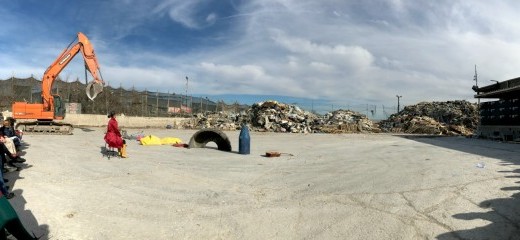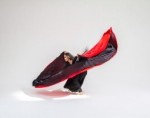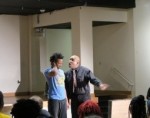
RAIR Game
by Jenna Horton
You can’t see the Delaware River,
Instead, you see Philadelphia’s junk.
And by junk, I mean foothills of “trash.”
Barely contained by a towering chain link fence, piles of discarded material seem to breathe at their edges—plastic and loose ends animated by any decent wind.
Almost like fur. Almost like feathers. Almost like lungs.
Maybe you have a mask on your face.
It depends.
On the choice you’ve made.
Regarding the dust, its toxicity and potential harm.
You are at RAIR (Recycled Artist in Residency), ensconced at Revolution Recovery, a 3.5-acre construction, demolition, and manufacturing waste recycling facility in Philadelphia that processes over 250 tons of materials per day. This is where stuff deemed junk goes to get sorted, and if it’s lucky, resuscitated.
You are sitting on metal bleachers, perhaps, looking out across the tundra of mostly brown and gray, retch and rust.
But the material of a shiny rich red coat catches your eye.
And look.
Just below it.
A pair of plastic yellow boots.
Inside this coat, wearing these boots, is designer Maiko Matsushima.
She sits upright on a short stool, her hair drawn up in a ponytail.
Her spine communicates focus and attention.
She sits facing the landscape.
A 5-ton waste excavator sits thirty feet to the left.
It is orange. With a big metal claw.
Inside this excavator sits its operator, the co-founder of RAIR, the bearded Billy Dufala, barely visible behind the dirty glass.
He too faces the landscape.
We all face the landscape, as well as nine objects culled from it and now arranged in a clear line before us. They are:
1) the large metal skeleton of an outdoor tent
2) a long, red rubber hose
3) a broken guitar
4) a large boulder of cement, as big as the trunk of a car
5) a blue…what might you call that?
6) a long yellow tarp or banner
7) a wooden ladder
8) a neon-pink plastic sled
9) a huge tire cut in half
The Landscape Game begins.
In this game, two players take turns choosing and placing an object one at a time, until all the objects have been placed in the space.
The rules, available to participants and watchers alike, center on consideration of space and time. Amongst them:
“Listen to the space, let it tell you where to place the object. Imagine that the brain that decides where the object goes is the brain of the space, not in your head. Maybe that sounds weird but try it.”
“Each time you place an object you are completing the picture, as if there were not going to be any more placements.”
This is not a game of football, or hockey, or even horseshoes.
It is a game of observation.
Or, as David Brick put it to the attendees of this particular River Charrette (one of four co-produced by Headlong and Philadelphia Contemporary):
“Observe yourself observing.”
So, in some ways, although I share an external map of moves and gestures made by this particular quartet— Matsushima, Dufala, these objects, this landscape—
the choreography I experience is my own.
Having played the same game multiple times at the Washington St. Pier, I can say with confidence that the game is quietly miraculous at bringing attention to what is. Five-ton excavator or no, the game excavates—quality, relationship, site, and presence. Today, here at RAIR, is no exception. And with machine and human playing as partners, their particular differences begin to come to the fore.
The excavator hums on and jolts forward. It is headed toward the broken guitar: it’s Billy’s turn. As the claw drops and approaches, the simple truth resounds: the claw is not a hand. It seems an obvious thing to state, but all of a sudden, the dexterous coordination and sensitivity required of human hands to handle (no less to play) a guitar jumps forward into attention. Witnessing in real time the claw’s attempts to consider the guitar (beyond the utility of moving it from one pile to the next) engrosses me. A focus so full, it reminds me of my childhood, when exploring water and shovel and sand were more than sufficient to keep my attention.
When the questions—
What does this thing do?
What does this thing mean?
How does this thing work?
What does this thing say?
How does this thing relate?
Where do I end and where do you begin?
were really in play.
What was your game like?
The Quiet Circus: River Charrette 2 at RAIR, Philadelphia Contemporary and Headlong, April 8
You can play the Landscape Game (sans 5-ton excavator) at the Washington Avenue Pier every Saturday 11am-1pm, March 18-May 20 as part of The Quiet Circus.
By Jenna Horton
April 19, 2017










